#The First Full-Size 3D Scan of The Titanic
Explore tagged Tumblr posts
Video
tumblr

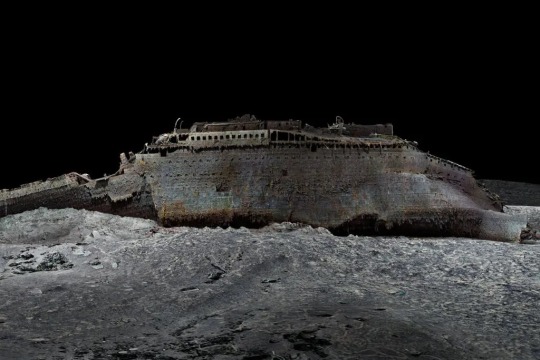
The First Full-Size 3D Scan of The Titanic
The mysterious 1912 sinking of the luxury passenger liner, the Titanic, has long served as a source of fascination for many.
Historians now believe that a new underwater scanning project may provide answers to some of the unanswered questions regarding the tragedy that killed more than 1,500 people.
A team of scientists have used deep sea mapping to create “an exact ‘Digital Twin’ of the Titanic wreck for the first time,” according to a press release Wednesday from deep sea investigators Magellan and filmmakers Atlantic Productions.
By carrying out the “largest underwater scanning project in history,” scientists have managed to “reveal details of the tragedy and uncover fascinating information about what really happened to the crew and passengers on that fateful night” of April 14, 1912, the press release said.
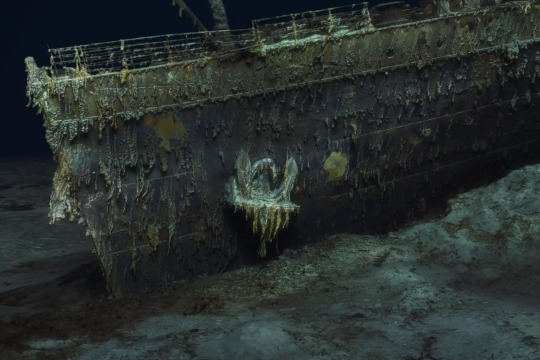
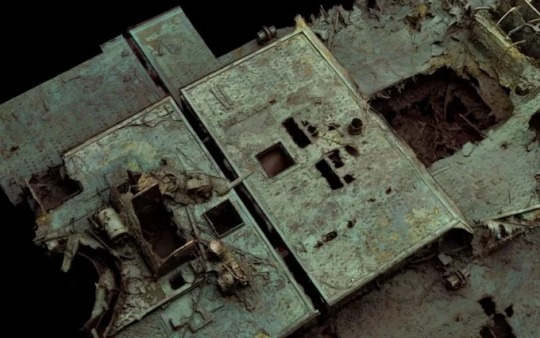
Scans of the wreck were carried out in the summer of 2022 by a specialist ship stationed 700 km (435 miles) off the coast of Canada, according to the release. Tight protocols prohibited team members from touching or disturbing the wreck which investigators stressed was treated with the “utmost of respect.”
Every millimeter of its three-mile debris field was mapped in minute detail, the press statement said. The final digital replica has succeeded in capturing the entire wreck including both the bow and stern section, which had separated upon sinking in 1912.
One such example can be found on the propeller where the serial number can be seen for the first time in decades.
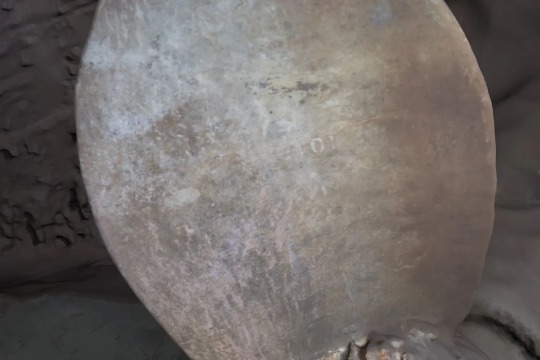
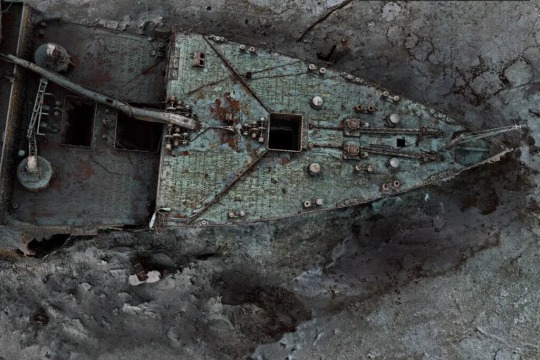
Roughly 715,000 images and 16 terabytes of data were gathered during the expedition – which Magellan estimates to be “approximately ten times larger than any underwater 3D model that’s ever been attempted before,” Magellan CEO Richard Parkinson said.
Parkinson described the mission as “challenging,” referencing the team’s fight against “the elements, bad weather, and technical challenges.”
Whereas previous optical images of the ship were limited by low light level and the poor light quality 12,500 feet below water, the new mapping technique has “effectively taken away the water and let in the light,” the press release said.
According to 3D capture specialist Gerhard Seiffert, the “highly accurate photorealistic 3D model” has enabled people to zoom out and look at the entire wreck “for the first time.”
“This is the Titanic as no one had ever seen it before,” Seiffert added.
By Niamh Kennedy.

#Titanic#The First Full-Size 3D Scan of The Titanic#British passenger liner#White Star Line#Atlantic Productions
249 notes
·
View notes
Text
Titanic: First ever full-sized scans reveal wreck as never seen before

Titanic departing Southampton on 10 April 1912
By Rebecca Morelle and Alison Francis
BBC News Climate and Science
17 May 2023
The world's most famous shipwreck has been revealed as never seen before.
The first full-sized digital scan of the Titanic, which lies 3,800m (12,500ft) down in the Atlantic, has been created using deep-sea mapping.
It provides a unique 3D view of the entire ship, enabling it to be seen as if the water has been drained away.
The hope is that this will shed new light on exactly what happened to the liner, which sank on 15 April 1912.
More than 1,500 people died when the ship struck an iceberg on its maiden voyage from Southampton to New York.
"There are still questions, basic questions, that need to be answered about the ship," Parks Stephenson, a Titanic analyst, told BBC News.
He said the model was "one of the first major steps to driving the Titanic story towards evidence-based research - and not speculation."
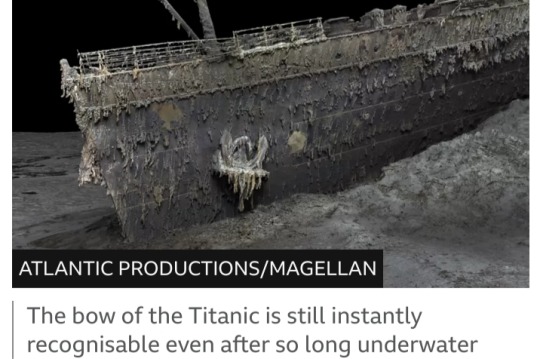
The Titanic has been extensively explored since the wreck was discovered in 1985.
But it's so huge that in the gloom of the deep, cameras can only ever show us tantalizing snapshots of the decaying ship - never the whole thing.
The new scan captures the wreck in its entirety, revealing a complete view of the Titanic.
It lies in two parts, with the bow and the stern separated by about 800m (2,600ft). A huge debris field surrounds the broken vessel.
The scan was carried out in summer 2022 by Magellan Ltd, a deep-sea mapping company, and Atlantic Productions, who are making a documentary about the project.
Submersibles, remotely controlled by a team on board a specialist ship, spent more than 200 hours surveying the length and breadth of the wreck.
They took more than 700,000 images from every angle, creating an exact 3D reconstruction.
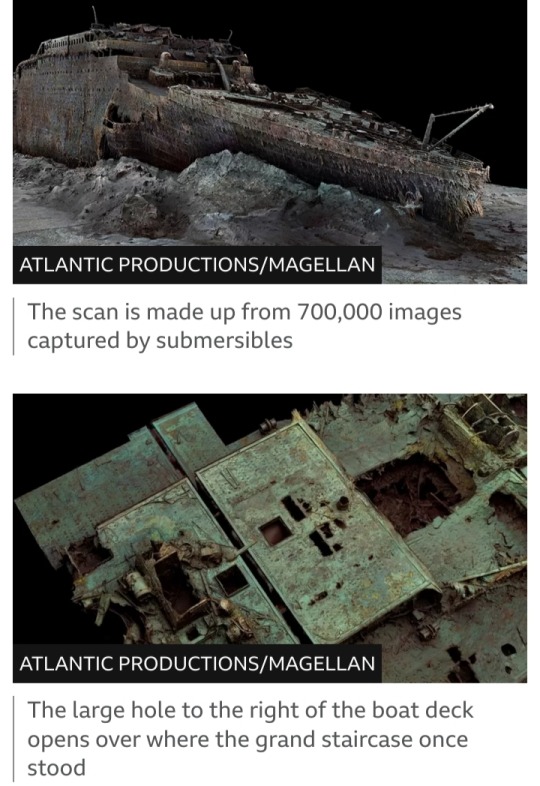
Magellan's Gerhard Seiffert, who led the planning for the expedition, said it was the largest underwater scanning project he'd ever undertaken.
"The depth of it, almost 4,000m, represents a challenge, and you have currents at the site, too - and we're not allowed to touch anything so as not to damage the wreck," he explained.
"And the other challenge is that you have to map every square centimetre - even uninteresting parts, like on the debris field you have to map mud, but you need this to fill in between all these interesting objects."
The scan shows both the scale of the ship, as well as some minute details, such as the serial number on one of the propellers.

The bow, now covered in stalactites of rust, is still instantly recognisable even 100 years after the ship was lost.
Sitting on top is the boat deck, where a gaping hole provides a glimpse into a void where the grand staircase once stood.
The stern though, is a chaotic mess of metal. This part of the ship collapsed as it corkscrewed into the sea floor.
In the surrounding debris field, items are scattered, including ornate metalwork from the ship, statues and unopened champagne bottles.
There are also personal possessions, including dozens of shoes resting on the sediment.

Parks Stephenson, who has studied the Titanic for many years, said he was "blown away" when he first saw the scans.
"It allows you to see the wreck as you can never see it from a submersible, and you can see the wreck in its entirety. You can see it in context and perspective. And what it's showing you now is the true state of the wreck."
He said that studying the scans could offer new insight into what happened to the Titanic on that fateful night of 1912.
"We really don't understand the character of the collision with the iceberg. We don't even know if she hit it along the starboard side, as is shown in all the movies - she might have grounded on the iceberg," he explained.
Studying the stern, he added, could reveal the mechanics of how the ship struck the sea floor.

The sea is taking its toll on the wreck, microbes are eating away at it and parts are disintegrating.
Historians are well aware that time is running out to fully understand the maritime disaster.
But the scan now freezes the wreck in time and will allow experts to pore over every tiny detail.
The hope is that the Titanic may yet give up its secrets.
#Titanic#shipwreck#deep-sea mapping#RMS Titanic#Magellan Ltd#Atlantic Productions#Gerhard Seiffert#Parks Stephenson#White Star Line#North Atlantic Ocean#15 April 1912#iceberg#digital scan#3D reconstruction
23 notes
·
View notes
Text
History: A Remarkable New View of the Titanic Shipwreck is Here, Thanks to D eep-sea Mappers
— May 20, 2023 | By Rachel Treisman
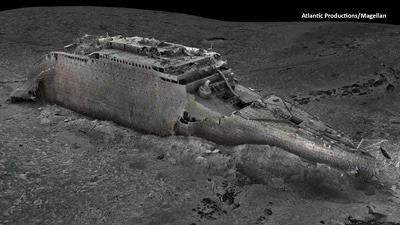
Scientists were able to map the entirety of the shipwreck site, from the Titanic's separated bow and stern sections to its vast debris field. Atlantic/Magellan
A deep sea-mapping company has created the first-ever full-sized digital scan of the Titanic, revealing an entirely new view of the world's most famous shipwreck.
The 1912 sinking of the Titanic has captivated the public imagination for over a century. And while there have been numerous expeditions to the wreck since its discovery in 1985, its sheer size and remote position — some 12,500 feet underwater and 400 nautical miles off the coast of Newfoundland, Canada — have made it nearly impossible for anyone to see the full picture.
Until now, that is. Using technology developed by Magellan Ltd., scientists have managed to map the Titanic in its entirety, from its bow and stern sections (which broke apart after sinking) to its 3-by-5-mile debris field.
The result is an exact "digital twin" of the wreck, media partner Atlantic Productions said in a news release.
"What we've created is a highly accurate photorealistic 3D model of the wreck," 3D capture specialist Gerhard Seiffert says. "Previously footage has only allowed you to see one small area of the wreck at a time. This model will allow people to zoom out and to look at the entire thing for the first time ... This is the Titanic as no one had ever seen it before."
The Titanic site is hard to get to, hard to see and hard to describe, says Jeremy Weirich, the director of the National Oceanic and Atmospheric Administration's Ocean Exploration program (he's been to the site).
'Titanic' was king of the world 25 years ago for a good reason
"Imagine you're at the bottom of the ocean, there's no light, you can't see anything, all you have is a flashlight and that beam goes out by 10 feet, that's it," he says. "It's a desert. You're moving along, you don't see anything, and suddenly there's a steel ship in front of you that's the size of a skyscraper and all you can see is the light that's illuminated by your flashlight."
This new imagery helps convey both that sense of scale and level of detail, Weirich tells NPR.
youtube
Magellan calls this the largest underwater scanning project in history: It generated an unprecedented 16 terabytes of data and more than 715,000 still images and 4k video footage.
"We believe that this data is approximately ten times larger than any underwater 3D model that's ever been attempted before," said Richard Parkinson, Magellan founder and CEO.
James Cameron aims to finally put that 'Titanic' door debate to rest, 25 years later
Experts in Titanic history and deep-sea exploration are hailing the model as an invaluable research tool. They believe it could help scientists and historians solve some of the ship's lingering mysteries — and learn more about other underwater sites, too.
Longtime Titanic explorer and analyst Parks Stephenson described the model as a "game changer" in a phone interview with NPR.
"It takes [us] further into new technology that's going to be the standard, I think, not just for Titanic exploration, but all underwater exploration in the future," he adds.
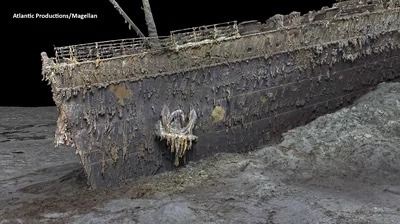
The effort yielded 16 terabytes of data and more than 715,000 still images, in what Magellan calls the largest underwater scanning project ever. Atlantic/Magellan
A Project Years in the Making, Featuring Romeo and Juliet
Explorers and artists have spent decades trying to depict the Titanic wreck, albeit in lower-tech ways.
After Robert Ballard — along with France's Jean-Louis Michel — discovered the site in 1985, he combined all of his photos to form the first photomosaic of the wreck, which showed the ship's bow and was published in National Geographic. Those efforts have been replicated in the years since.
"But the problem with all that is it requires interpretation," Stephenson says. "It requires human interpretation, and there are gaps in the knowledge."
Flash forward to the summer of 2022. Scientists spent six weeks capturing scans of the site, using technology that Magellan says it had been developing over the course of five years.
The expedition deployed two submersibles, named Romeo and Juliet, some 2.3 miles below the surface to map every millimeter of the wreck site.
They didn't go inside the ship, let alone touch the site, in accordance with existing regulations, and paid their respects to the more than 1,500 victims with a flower laying ceremony.
And they describe the mission as a challenge, with the team fighting bad weather and technical challenges in the middle of the Atlantic.
"When we saw the data come in it was all worth it," Seiffert says. "The level of detail we saw and recorded was extraordinary."
The scientists spent months processing and rendering the data to create the "digital twin," which the company says it's looking forward to sharing publicly.
Stephenson saw an early version of the model, when Atlantic Productions brought him on to consult on its validity. So did Ken Marschall, the maritime artist known for his Titanic paintings.
"We've both seen it with our eyes. We've both seen thousands of digital images of the wreck in imagery, moving imagery," Stephenson said. "But we'd never seen the wreck like this. It was different, but at the same time you just knew it was right."
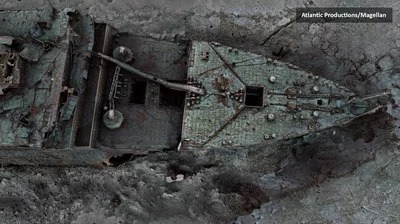
Experts say the model will be a valuable tool for future Titanic research and deep-sea exploration in general. Atlantic/Magellan
There's Still a Lot Left to Learn About the Titanic
Can there really be that much left to discover about the Titanic, more than 110 years on?
Stephenson says "at the end of the day, none of this matters." But there's a reason people keep visiting and talking about the wreck, he adds, and it's not because of any buried treasure.
"It's fame, I guess," Stephenson says. "People can't get enough of Titanic. And as long as people can't get enough of the Titanic, people will keep going to ... these mysteries."
In Stephenson's case, it's the unanswered questions that keep drawing him back.
"I've been grinding away at this for a while, and I'm not on a crusade to dismantle the Titanic narrative that has grown since 1912," he says. "But ... I have had enough experience and seen enough evidence that makes me seriously question even some of the most basic aspects of the Titanic story."
One example: Stephenson says there's reason to doubt the long-accepted conclusion that the ship hit the iceberg along its starboard side. He points to a growing body of evidence that suggests it actually grounded briefly on part of the iceberg that was submerged underwater instead.
Just looking at the preliminary modeling has helped Stephenson bring a lot of his evidence and questions into focus — it may be early days, but he says he already has a better understanding of how the ship's stern came to be in such bad shape.
Stephenson sees this moment as a paradigm shift in underwater archaeology.
"We're essentially getting to the end of the first generation of Titanic research and exploration, and we're getting ready to transition into the next generation," he says. "And I think this tool basically signals a shift from that generation to the next."
Stephenson wants to use the model to document the extent of Titanic exploration up to this point, from Ballard to James Cameron and beyond. He says a "massive project" is underway, and will hopefully result in a scientific paper and online archive. Then, he plans to use the tool to answer whatever questions remain.

There have been "photomosaics" and other renderings of the shipwreck over the decades, but this is the first such 3D model. Atlantic/Magellan
The Titanic is a Gateway Into Deep Ocean Exploration
As a maritime archaeologist, Weirich is most interested in what the ship's condition can teach us about how to better preserve deep-sea shipwrecks in general. For example, how has it impacted the environment since it sunk, and how have the visits since its discovery impacted the site?
The Titanic site has been designated as a maritime memorial, which makes preservation even more important. And Weirich says research on everything from its rate of deterioration to the microbial environment can be applied to other such sites worldwide.
There are estimated to be hundreds of thousands of wrecks in the world, from ancient wooden ships in the Black Sea to World War II vessels in the Gulf of Mexico, Weirich says.
And this kind of technology could play a crucial role in learning more about deep-sea environments in general, from undersea resources to geological features to unknown species.
Weirich says he hopes these images of the Titanic will give people a greater appreciation for the deep ocean, and a better understanding of just how much is left to explore.
"The story of Titanic and the shipwreck itself is extremely compelling, but it is a gateway for people to understand what we know and don't know about the deep ocean," he adds.
Weirich remembers being personally captivated by those first images of the shipwreck in National Geographic when he was just 10 years old. That sparked his lifelong interest in ocean exploration — and he hopes young people seeing these latest images are inspired too.
2 notes
·
View notes
Text
Unveiling the Titanic: Exploring the First 3D Model of the World-Famous Shipwreck
Introduction: Join us as we delve into the groundbreaking 3D model of the Titanic, offering a fresh perspective on one of the most iconic shipwrecks in history. Unveiling the Titanic’s 3D Model In a monumental feat, experts have created the first full-size 3D model of the Titanic, shedding new light on the sunken ship’s structure and detailing. This digital scan offers a mesmerizing view of the…

View On WordPress
1 note
·
View note
Text
Unwind and Recharge: Top Massage Chairs for Under $2,000
Let's face it, life throws a lot at us. Between work, family, and the daily grind, our bodies (and minds!) crave some serious TLC. Enter the magical world of massage chairs – your personal oasis of relaxation right at home. But with so many options, finding the "best" massage chair under $2,000 can feel like navigating a maze blindfolded. Worry not, fellow stress warriors! I'm here to guide you through the features, functions, and fabulousness of top contenders in this budget-friendly range.
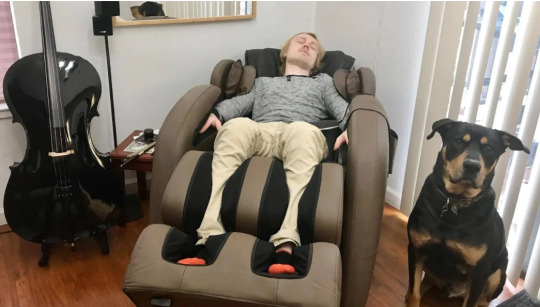
First things first, consider your needs:
The Aching Truth: Do you suffer from chronic back pain, tight muscles, or just general tension? Knowing your pain points helps narrow down features like massage styles (shiatsu, Swedish, kneading) and roller track length (full-body vs. focused).
Size Matters: Are you a towering giant or a petite powerhouse? Ensure the chair accommodates your height for optimal comfort and massage coverage.
Tech Talk: Do you crave a fully loaded experience with Bluetooth speakers, heat therapy, and zero-gravity recline? Or are you more of a "just the essentials" kind of person? Prioritize features that matter most to you.
Now, let's explore some champions in the under-$2,000 arena:
The All-Rounder: Osaki OS-7030 Meridian boasts a long L-track massage, 3D rollers for deep tissue work, and adjustable air compression for targeted relief. Bonus points for its sleek design and user-friendly remote.
The Tech-Savvy Choice: Kahuna LM-6800 comes equipped with Bluetooth speakers, lumbar heat therapy, and a space-saving design. Its "yoga stretch" program adds a unique twist to the relaxation experience.
The Value Champion: Real Relax 2020 Favor 03 offers exceptional value with its full-body massage, zero-gravity recline, and foot rollers. Perfect for those seeking a no-frills but effective massage experience.
The Luxury Pick: Titan Atlas Max delivers a spa-like experience with its 4D massage technology, chromotherapy lighting, and advanced body scan for a personalized touch. Ideal for those who want the ultimate in pampering.
Remember, the "best" chair is the one that fits your body, budget, and preferences. Try them out if possible! Read reviews, compare features, and don't be afraid to ask questions. After all, this is about unlocking a world of relaxation and rejuvenation, and that's definitely worth the investment.
Bonus Tip: Look for brands with good customer service and warranty policies for peace of mind.
So, are you ready to trade tension for tranquility? With the best massage chair under $2,000, you can melt away stress, soothe achy muscles, and recharge your mind and body. Happy massaging!
1 note
·
View note
Text
Titanic shipwreck shown in 3D view
Video shows the Titanic shipwreck in a unique 3D view, in footage released earlier this year. The first full-sized digital scan of the Titanic, which lies 3,800m (12,500ft) down in the Atlantic, was created using deep-sea mapping. Read more: Scans of Titanic reveal wreck as never seen before Video courtesy of Atlantic Productions/Magellan

View On WordPress
0 notes
Text
Titanic shipwreck shown in 3D view
Video shows the Titanic shipwreck in a unique 3D view, in footage released earlier this year. The first full-sized digital scan of the Titanic, which lies 3,800m (12,500ft) down in the Atlantic, was created using deep-sea mapping. Read more: Scans of Titanic reveal wreck as never seen before Video courtesy of Atlantic Productions/Magellan

View On WordPress
0 notes
Text
First Full-Size 3D Scan Of Titanic Reveals Unprecedented Details Of The Shipwreck
Deep-sea researchers have just accomplished an extraordinary feat — the first full-size digital scan of the Titanic, uncovering the entire wreck with unparalleled detail and clarity. The companies involved in an upcoming documentary on the Titanic shared this remarkable achievement on Thursday (05/18/2023). To contextualize, on April 15 (1912) during its maiden voyage from Southampton, England,…

View On WordPress
0 notes
Text
Titanic: First full-size 3D scan of Titanic shows shipwreck in new light
LONDON: Deep-sea researchers have completed the first full-size digital scan of the Titanic, showing the entire wreck in unprecedented detail and clarity, the companies behind a new documentary on the wreck said Thursday.Using two remote operated submersibles, a team of researchers spent six weeks last summer in the North Atlantic mapping the whole shipwreck and the surrounding 3-mile debris…

View On WordPress
0 notes
Text
Titanic: Scan reveals world's most famous wreck
By Rebecca Morelle and Alison Francis The world’s most famous shipwreck has been revealed as never seen before. The first full-sized digital scan of the Titanic, which lies 3,800m (12,500ft) down in the Atlantic, has been created using deep-sea mapping. It provides a unique 3D view of the entire ship, enabling it to be seen as if the water has been drained away. The hope is that this will…

View On WordPress
0 notes
Text
Titanic: First Ever Full-Sized Scans Reveal Wreck As Never Seen Before
— 17 May 2023 | By Rebecca Morelle and Alison Francis

The bow of the Titanic is still instantly recognisable even after so long underwater
The world's most famous shipwreck has been revealed as never seen before.
The first full-sized digital scan of the Titanic, which lies 3,800m (12,500ft) down in the Atlantic, has been created using deep-sea mapping.
It provides a unique 3D view of the entire ship, enabling it to be seen as if the water has been drained away.
The hope is that this will shed new light on exactly what happened to the liner, which sank in 1912.
More than 1,500 people died when the ship struck an iceberg on its maiden voyage from Southampton to New York.
"There are still questions, basic questions, that need to be answered about the ship," Parks Stephenson, a Titanic analyst, told BBC News.
He said the model was "one of the first major steps to driving the Titanic story towards evidence-based research - and not speculation."

The bow of the Titanic is still instantly recognisable even after so long underwater
The Titanic has been extensively explored since the wreck was discovered in 1985. But it's so huge that in the gloom of the deep, cameras can only ever show us tantalizing snapshots of the decaying ship - never the whole thing.
The new scan captures the wreck in its entirety, revealing a complete view of the Titanic. It lies in two parts, with the bow and the stern separated by about 800m (2,600ft). A huge debris field surrounds the broken vessel.
The scan was carried out in summer 2022 by Magellan Ltd, a deep-sea mapping company, and Atlantic Productions, who are making a documentary about the project.
Submersibles, remotely controlled by a team on board a specialist ship, spent more than 200 hours surveying the length and breadth of the wreck.
They took more than 700,000 images from every angle, creating an exact 3D reconstruction.

The scan is made up from 700,000 images captured by submersibles

The large hole to the right of the boat deck opens over where the grand staircase once stood
Magellan's Gerhard Seiffert, who led the planning for the expedition, said it was the largest underwater scanning project he'd ever undertaken.
"The depth of it, almost 4,000m, represents a challenge, and you have currents at the site, too - and we're not allowed to touch anything so as not to damage the wreck," he explained.
"And the other challenge is that you have to map every square centimetre - even uninteresting parts, like on the debris field you have to map mud, but you need this to fill in between all these interesting objects."
The scan shows both the scale of the ship, as well as some minute details, such as the serial number on one of the propellers.

The stern, which has separated from the bow, is a chaotic tangle of steel

The stern corkscrewed into the seabed as it plunged into the depths
The bow, now covered in stalactites of rust, is still instantly recognisable even 100 years after the ship was lost. Sitting on top is the boat deck, where a gaping hole provides a glimpse into a void where the grand staircase once stood.
The stern though, is a chaotic mess of metal. This part of the ship collapsed as it corkscrewed into the sea floor.
In the surrounding debris field, items are scattered, including ornate metalwork from the ship, statues and unopened champagne bottles. There are also personal possessions, including dozens of shoes resting on the sediment.

Extraordinary detail can be seen of the ship

The serial number on a propeller can be made out
Parks Stephenson, who has studied the Titanic for many years, said he was "blown away" when he first saw the scans.
"It allows you to see the wreck as you can never see it from a submersible, and you can see the wreck in its entirety, you can see it in context and perspective. And what it's showing you now is the true state of the wreck."
He said that studying the scans could offer new insight into what happened to the Titanic on that fateful night of 1912.
"We really don't understand the character of the collision with the iceberg. We don't even know if she hit it along the starboard side, as is shown in all the movies - she might have grounded on the iceberg," he explained.
Studying the stern, he added, could reveal the mechanics of how the ship struck the sea floor.

The hope is that the scan could reveal more about what happened on the night the Titanic was lost
The sea is taking its toll on the wreck, microbes are eating away at it and parts are disintegrating. Historians are well aware that time is running out to fully understand the maritime disaster.
But the scan now freezes the wreck in time, and will allow experts to pore over every tiny detail. The hope is the Titanic may yet give up its secrets.

The Titanic was the world's largest passenger ship when it entered service
#RMS Titanic#Sinking of the Titanic#Full-Sized Scan | Titanic#Revelation of Wreckage#Never Seen Before#BBC News 🗞️ 📰#Rebecca Morelle and Alison Francis#Climate & Science
1 note
·
View note
Link
‘Digital twin’ of ship created by deep-sea mapping firm may help shed new light on 1912 sinkingThe Titanic has been depicted in unprecedented detail in the first full-sized digital scan of the wreck.The unique 3D view of the entire...
0 notes
Text
Titanic: Full-sized scans show shipwreck like never before
More than a century after it sank, the first ever full-sized scans of the Titanic show the historic shipwreck in astonishing detail. Experts have taken thousands of digital images to create a stunning 3D reconstruction of the wreck, which now lies 350 nautical miles off the coast of Newfoundland, Canada. The images, published by the BBC, reveal the wreckage in greater detail than ever before,…

View On WordPress
0 notes
Text
Treasure detector
A treasure detector is any metal detector that can detect all kinds of underground metal objects whether precious metals such as gold, silver, copper or non-precious metals such as iron, aluminum and others.
The best quality treasure detector is a three-dimensional imaging device that scans the earth spatially through a special search sensor and can display the results of the survey in the form of a three-dimensional space within a computer or tablet so that gives the prospector a full idea of the nature of the buried treasure and the depth and size.
Nevertheless, treasures of great value can be discovered by relatively inexpensive devices operating on a disk-based electromagnetic search system where treasures buried at small depths of less than three meters can be found, such as gold coins, gold jewelry or small metal objects.
What do we mean by treasure?
A treasure is anything made from precious metals, often gold, which has a great archaeological, historical or cultural value and even a substantial material value if sold by antiquities dealers.
For example:
· Boxes made of gold with ancient coins
· Jars containing gold coins or coins may be from previous civilizations
· Swords made of gold, bronze or some alloy
· Gold and jewelery such as bracelets, rings or hoops used to decorate women
· Ancient weapons such as daggers, armor and others were used in the war
Example about Treasure Detector
eXp 6000
eXp 6000 is considered a most powerful metal detector thanks to its wide range
of metal detecting and ground scanning capabilities with most complete features set.
eXp 6000 use a unique Germany technology from OKM in the field of 3D Imaging search system
the first geophysical detection system in the world with best results.
It is the best choice ever for any serious treasure hunter and professional prospector .
Titan Ger 1000
Titan Ger 1000 is the one and the only device in the world,which combines five different search systems for metal and gold detection in one device, and it has also all the needed features for any treasures hunting.
Anyone can easily use The Titan Ger 1000 device as one of the built-in systems by plugging right components and sensors for every system, and the user can get more than one system in order to make more accurate and reliable results.
Nokta Invenio
Nokta Invenio has a special technology, which is a 3D imaging metal detector for searching gold
metals, and artifacts, and that is one of the best metal detecting technologies in the recent years.
That 3D imaging technique has been patented internationally because of its features of showing the precise shape of the underground metal objects suitable for treasure hunting.
The Invenio treasure detector uses a traditional search coil with electronic components, unlike most of the other imaging devices.
For more information, please visit:
https://orient-tec.com/
0 notes
Text
My specialist practice
What is an animated VFX artist?
An animated visual effects artist usually specialises in creating and or manipulating imagery or video using computers then adding them into live action shots to give the illusion that someone or something real is interacting with something else that if done using no technology would be much more difficult to do. Timing and physics also play a crucial role in VFX as they’re required to help achieve the most realistic effect.
Common materials and techniques used in VFX
Software used in VFX often has to have the capability to work with 3D software and multiple layers, these softwares include but are not limited to 3D Max, After Effects, Boujou, Cinema 4D, Maya and Nuke.
Common techniques include green screening where something or someone is filmed performing an action in front of a screen of one colour. Due to the green screen, the action in front of the screen can be put onto its own layer then placed in front of another background. Motion tracking is often used also but for more when someone or something real is to interact with an object, motion tracking can also be used to edit the position, scale, orientation, and overall motion.

Matte painting is used to combine two or more different images/scenes into one such as placing actors into background images. Often used to create the illusion of a setting and is used in almost all live-action films. Matte paintings are now often created in computer programs but originated as actual paintings which were added to photographs.

Physical simulators are used to create dynamic simulations which are often very hard to pull off and are common amongst big budget movies such as 2012.

Rotoscoping is another technique used by VFX artists where something real is recorded and the artist goes over the object or character to get the correct motion and be able to be as accurate as possible.

History of VFX and How long it has been practised
VFX first started to be used in films since the late 1800s, although not digital, props were used to change how something appeared, for example, Georges Méliès would use cloth or card to cover part of the camera lens to prevent light reaching areas of the film.
youtube
In 1975 Industrial light and magic founded by George Lucas used computers to create VFX in the movie Star Wars. the computers would be used to control the cameras and remember the movements used by the VFX teams. This was done so that a camera not in motion wouldn’t have to be surrounded by moving objects to create the same effect. So far Industrial light and magic have worked on over 300 films which gained them vast amounts of experience to make their VFX look more realistic than before.

In 1982 for the film Tron computer animation was used to help develop the plot and characters. Tron also used an effect called backlit animation which shined light and therefore, creating a glowing light on the characters and the background.

For movies such as planet of the apes and Godzilla, actual people in costumes and sometimes animatronics would be used to form characters as this would still look the most believable at the time. Decades later during the remakes of the movies, full-motion tracking was used to create the character’s appearance.
This method goes far back as 1938 where the voice actors for Snow White would also act out the scenes in front of the animators to give them a better understanding of how certain actions would be carried out.

21st century VFX -
colour grading -
Although colour grading had been used in previous movies for large shots and in some scenes it was during the 2000s that this is when a full movie was colour graded using computers. Now almost all movies have colour grading created digitally to create certain atmospheres and moods.
Water -
Before the 2000s it was near impossible to create water that looked fully believable but during 2000 industrial light magic created a solution to combine the two approaches of calculating particle by particle and considering all of the fluid at once. This required the use of volume calculations for larger portions of the water and droplet type simulation for when they broke down. This technique was first debuted in the 2000 film The Perfect Storm.

Artificial Intelligence -
This method was first used in The Lord Of The Rings to generate large battle sequences instead of hiring thousands of actors. Each character would be randomised with their size, proportions, and outfits all being different. Each character would then be given a range of actions for them to perform in a time frame.

Universal capture -
Multiple 3D scannings of the actor speaking and/or carrying out actions from different angles would be recorded where each different pixel would be motion tracked. This would allow the VFX designers to apply the same face to 3D models.

Live rendering technology -
This technique was first used on the film Avatar which took over 10 years to make, this technique allowed James Cameron to stage his motion-captured actors and in real time watch the simplified CGI performances created from their movements. This technique changed the VFX industry so guessing and measuring weren’t needed as there was real-time feedback.
Avatar was also the first film to involve a motion tracked dummy camera which would be used to control a virtual camera so operators could film scenes and watch them at the same time on their monitors.

How is my specialism practised today?
VFX is used almost all of the time in different media such as games, animation, and most if not all live action films. In films specifically, it’s important that they do well at the box office as it keeps the VFX industry afloat, research reveals that this is not in danger as in the U.S. and Canada alone they earned $11.8 billion in ticket sales for 2017 and in 2018 $11.9 billion. All of the top 10 highest grossing films in the U.S. were either VFX heavy or computer-animated films. Many of the most popular streaming shows also relied heavily on the use of VFX. VFX is being used more and more within movies, to compare the Titanic in 1997 only had a total of around 300 VFX shots and Infinity War in 2018 had over 3000 which has become the standard. This creates more jobs to work on the films and also higher wages for the VFX supervisors as the budget becomes a lot larger and having them supervise more artists.
New technologies are also being created to be used by artists to design virtual reality visuals and general 360 videos so it’s common for artists and coders who also work on the team to learn the new software and use it to their advantage.
The future of the VFX industry -
It’s expected that demand for VFX will increase over time as more movies with higher budgets are made, it’s also thought that the industry will focus more on creating more realistic CG human characters which can replace the actor, the best example of this happening now would be the CG Paul Walker in Furious 7 in 2015. However, as demand increases the technology will also develop causing workers to have to be up to date and learning the new software. A lot of people also do VFX as a second job as the financial intake can be unstable.

The people in the VFX industry
The general income -
It mainly depends on how much experience one has in the industry and where the workplace is located. Within the first year, it’s expected to be only around £15,000 to £17,000. From one to three years in the industry, the average salary is to be around £27,000. A mid-level artist with four to seven years experience can earn around £38,000. And a senior VFX artist with over seven years could make around £54,000. These numbers are just by experience but there are multiple other factors which can affect the income of an artist such as the role they carry out.
The roles -
Runner -
Using VFX to create multiple outcomes for a company is all about teamwork comprised of people at different levels. When first going into the VFX industry it’s likely the person will start off in the “Runner” role which is an entry-level position. Runners are just general helpers at the studio with duties that may not be technical but can practice and learn from the more experienced VFX artists. This role normally is more common amongst people who may not have a somewhat relevant degree in the industry but have a decent portfolio that portrays their passion and interest for VFX. Runners only tend to make around £15,000 to £17,000 per year until they’re promoted which can take a few months or a few years.
VFX artist -
The next level is where you would find the artists who carry specify in certain areas such as rotoscoping, matte painting, 3D modelling, compositing artists and prep artists just to name a few. These are the main people behind the actual visuals for a project using their skills either learnt from a degree or taught from the previous artists when runners. At this stage, people would make around the amount of £25,000 to £30,000 depending on the company.

VFX Director -
Above the main artists are the directors. There are many different types of directors, for example, a pipeline director uses their coding skills to come up with scripts for the artists to use. A shader development director uses their skills to write codes to describe where and how lighting reflects from 3D objects onto different materials. Some directors specialise in rigging by also possibly creating the textures and muscle structure for certain characters. Another type of director goes by the title “assistant technical director” who maintains tools and scripts as well as helping out the artists when needed, they also render out quick time videos for people in higher stages or clients to review. The average salary of a VFX director varies from £40,000 to £60,000 depending on the role.

Production coordinator -
The next stage goes by the title of a production coordinator which is a specific role often not carried out by people who have worked in previous lower roles. The production coordinator’s job is to collect data and updates on tasks and feedback to work in progress. They pass along information from the client to the rest of the company and vice versa, this could be the idea of changing deadlines. The average salary of the production coordinator sits around £25,000 to £30,000 which is one of the reasons why this stage is not offered very often to lower roles.
VFX producer -
The producer works very closely to the person/people of the highest role to manage the whole VFX production process, defining what sources are needed and hiring new VFX artists and staff. They have to be able to listen to the client requirements and listen to the needs of the artists. The average salary for a VFX producer is between £50,000 and £70,000.

VFX supervisor -
The supervisors in larger studios take charge over individual departments such as a CG supervisor. Normally there are also supervisors over the whole VFX production who are normally hired by the directors of the TV show or movie or by the VFX company they work for that has been asked to carry out the production. A supervisor will have years upon years of experience with strong artistic, technical, and communication skills. The average salary of a VFX supervisor is between £80,000 and £120,000 depending on multiple things such as the size of the project or actual worth of the supervisor if they have a lot of credit to their name.

VFX pipeline and workflow -
Stage one, pre-production -
Research and development -
The first stage is research and development where it’s figured out which software/s and technique/s will be used along with how long it will take so they can estimate a deadline time to tell the client. During this stage, it’s taken into consideration what plugins will have to be used, a lot of plugins for films with a larger budget have to custom built and it’s normally the programmers, artists, mathematicians, and scientists who develop these tools to use for the rest of the project.
Pre-Visualization -
Pre-visualisation is where rough sketches and storyboards are converted into quick low quality 3D animated backgrounds to help give the directors of the project and idea of how the final piece could look.

Stage two, production -
3D modelling -
This process happens during all three stages of the production with different amounts of detail being developed depending on the stage the team are on. Like mentioned previously if the team are on stage one low-quality 3D models will be used and then perhaps built upon from there if the design looks workable.

Matte Painting -
Although most of the background is already 3D modelling, matte paintings are still used for certain aspects in the far distance such as buildings or sky colours. Matte Paintings can also give an idea to the 3D modellers for how the scene could look.

Reference photography -
During the recording process of the actors, certain VFX members will be on set to take pictures of the stage, props and the actors themselves for reference. These images can be used for the artists to think of possible sizes and textures and see how it can react with the light source/s depending on where it’s coming from.

Stage three, post-production -
Scene preparation -
Scene preparation is to prepare the provided footage for elements to be inserted in. This could be done by motion tracking, rotoscoping, keying or colour correcting.
Motion tracking -
Motion tracking tracks the 3D motion of the footage to simulate the camera movement so objects can be placed into scenes convincingly. Without this VFX that gets implemented whilst the camera is moving wouldn’t look as convincing and wouldn’t look seamless.

Colour correcting -
Colour correcting is the process of adjusting the light and colour profile on objects. This has to be done per shot to make the effect look consistent.
Colour grading -
This is something that’s carried out at the end of the project to also highlight certain areas but as well give the piece a more polished and finished look.

Rigging -
Rigging is to make the motion look far more realistic, an example of this would be making the limbs of a person rotate around the joints.

Animators -
Animators are the people who give the motion to the rigged objects to help portray the character's personality.

Polishing effects -
Effects and simulation -
The simulations mainly consist of explosions, smoke, and water which are made to be as realistic and believable as possible. Adding these effects requires a good understanding of physics and how certain forces could impact the look.

Texturing -
This is the step where surface colours and textures to the 3D models are added, this could be to give a certain metallic shine or just the look of human skin.
Final lighting -
Lighting is one of the most important stages of the whole project as poor lighting could be an easy giveaway that CGI has been used and make the piece look less believable. Because light during the day is much harder to replicate most of the shots where CGI is used is set at night.

Compositing -
Compositing is the final stage where all the created assets are put into the original recording with the actors by the compositor and the visuals for the project is complete.

Some key “individuals” in the VFX industry -
For my first “individual” I have decided to focus more on a company rather than a specific person for my research of as it would be easier to track the process with VFX not generally being carried by just one person.

The company hires more than 1,000 staff from VFX supervisors to Scientists to create the most realistic display, a lot of the VFX supervisors have multiple degrees to have the best understanding of how the industry works and what creates the best effect, for example, Habib Zargarpour has two bachelor’s degrees, one being in applied science and mechanical engineering and the other being for industrial design. Zargarpour was also the main person behind the water look used in The Perfect Storm as already mentioned.
The process of how one of their films gets created goes as such;
The script gets written
Sets of storyboards are created for each individual shot, if two characters are talking to each other and the camera focuses on one character then the other this would be considered two separate shots, this can cause a film to easily accumulate over 2500 shots. A lot of the time also during this stage very basic 3D animatics are generated carrying out the whole storyline then shown to the director/s to get confirmation that they have the correct ideas before more time is spent developing.
The film team then splits into several groups with one focussing on the designing and construction of the set. Another group starts the research and development process for the elements for the CG shots. Another group starts preparing all the shots for any scenes involving stunts. One group that focuses on the physical aspects such as animatronics to be used in the film. And the last of the groups prepare the cameras, lights, and sound equipment for different shots in the film.
The actual recordings for the film are then carried out.
CG elements and live action elements are added with some of the footage being removed such as cables and lights.
All of the shots and recordings captured are then placed together to create the story.
Possible sound effects are added and exaggerated.
Light and Magic example -
youtube
Key Individual -
For my individual, I have decided to research Joe Letteri born in Pennsylvania, The United States during 1957. Letteri has worked on numerous films such as Avatar with James Cameron, War for the Planet of the Apes, King Kong (2005), as well as multiple Lord of the Rings sequels, for some of these movies and more Letteri has won four Academy Awards, four BAFTA awards and four VES awards.

Joe Letteri would work closely with the director and producer of the film (as a VFX supervisor should) to create the best looking final project. Letteri would sort out which VFX is needed for each shot which would impact how the footage would be recorded. Next, Letteri would then work with his team to create a simple prototype animatic for the director and producers to examine.
Once the ideas of the designs are approved by the director and the producer, Letteri would work with the director to plan every shot during the film, this would require certain footage to be recorded in different ways as it would make the process for the VFX artists much easier.
Letteri would often rotate between set and studio (if not using live render technology as previously mentioned) to make sure that the techniques and technologies are being deployed correctly until the project is complete.
The role that Letteri fills requires a thorough understanding of 3D animation software and a very good understanding of current filmmaking techniques. Finally, Letteri needs good team leadership skills to be able to supervise a large team effectively with clear communication.
Joe Letteri work example -
youtube
Example of work from an independent (Samuel VIčan) -
vimeo
Looking at the three different examples of work it’s clear that it’s more of a long haul task with most of the time multiple people working on one project at once and if being carried out by an individual the quality of the final outcome will generally be lower than that of a team.
It’s also apparent that lighting, environment and good camera angles are taken into consideration when creating the visuals and play a larger role than I once thought.
General mood board containing different lighting, environments and textures -
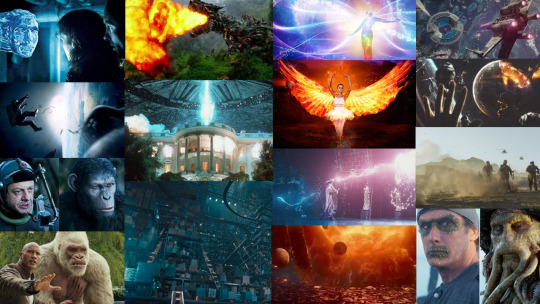
Sources -
History of VFX - https://www.youtube.com/watch?v=tsDdAXKtYAE
21st century VFX - https://www.youtube.com/watch?v=G0cPeEAhzWU
VFX Pipeline - https://myfirstjobinfilm.co.uk/resources/careers-guide/detail?page_id=1
Jobs in VFX - https://www.screenskills.com/careers/job-profiles/animation-games-and-vfx/vfx/
VFX techniques and process - https://www.premiumbeat.com/blog/how-an-average-vfx-pipeline-works/
Light and Magic research - https://entertainment.howstuffworks.com/perfect-storm1.htm
0 notes
Text
This is a 23-year-old male from Nagpur. He presented with complaints of diplopia in his right eye and a depression on the right side of the face. He has a history of RTA with emergent treatment of zygomaticomaxillary complex fracture. He was not happy with the outcome of the surgery. His diplopia had not been corrected by the surgery. He then searched the net for the best facial deformity correction surgeon. His search led him straight to our hospital.
Dr SM Balaji examined the patient. The patient had diplopia of the right eye. The diplopia was present only at the extremities of gaze. A 3D CT scan revealed a depressed and malunited right zygoma. Maxillofacial Surgeon Dr SM Balaji planned the treatment. He planned to correct the depression by refracturing the zygoma.
Frontal view showing depressed right side of the face
CT scan showing herniation of the right orbital contents
3DCT scan showing depressed right zygoma
Eversion of the right lower eyelid following transconjunctival incision
Right orbital floor reconstruction with Medpor Titan mesh
Right zygoma fracture elevated and fixed using Ti plates and screws
The right malunited zygoma was first exposed by a vestibular approach. The right zygoma was then refractured, elevated and fixed using Ti. plates and screws. The right orbital floor was then reconstructed with a Titan Medpor mesh. This was also fixed using titanium screws. He was very happy with the results of the surgery.
Successful surgical correction of diplopia and depressed zygoma #Diplopia #Zygoma #Deformity #FacialDeformity #CosmeticSurgery #Cosmetic #RTA #RoadTrafficAccident #Accident #Surgery #SMBALAJI #DRSMBALAJI This is a 23-year-old male from Nagpur. He presented with complaints of diplopia in his right eye and a depression on the right side of the face.
0 notes